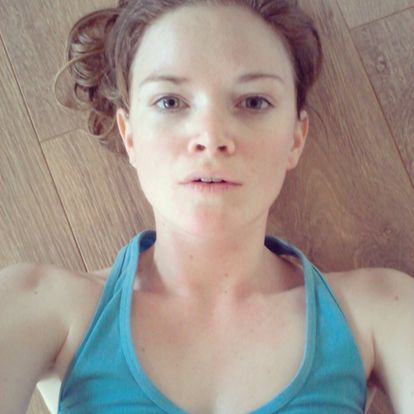
I’ve known the woman standing opposite me for a very long time. I have heard her stories, witnessed her pain, felt her joy, celebrated her highs and helped lick the wounds of her low’s.
She’s a woman who knows what she wants and makes a plan to get it. Once she’s decided what it is she wants there is nothing stopping her. Your options are to help her achieve her goals or jump out of her way!
She’s has achieved many things in her life. But, one thing has evaded her. The ability to control the number on the scales below her feet. She is convinced she has tried every single thing under the sun, but she’s addicted to comfort eating. The worst part of it all is that she eats in secret, scared of the scolding eyes of those around her.
She works out, walks a minimum of 12,000 steps a day, rides her mountain bike up the mountains behind her house at least twice a week and swims half a kilometre in the sea most evenings, exercise is not her problem.
She’s been through highs and lows with her weight. Some days she’s winning other days she’s spiralling out of control. She’s affected by her emotions and if the truth be told her lack of knowledge. She thinks she is making the right eating choices, actually, she truly believes it. She doesn’t eat butter or anything with any level of fat. She avoids sugar, using honey in its place – plenty of it. She is blissfully unaware of the sugar content of juice and drinks it for the vitamins, she cooks almost everything from scratch, except the pizza last night and the lazy I can’t really be bothered fish fingers the night before. Her office is above a bakery which is bad news for her. Like a moth drawn to the light in the night, she floats down the stairs on the wafting smell of freshly cooked bread and pastries. She knows the owners so gets to choose her favourites before anyone else, lunch is almost always from downstairs.
She thinks she knows what she is doing but the truth is she has no idea.
She’s been living in perpetual summer for the last couple of years. Loose clothing and bikinis make up 99.9% of her wardrobe choices. She has chosen to ignore the signs, the rings getting tighter, the fact that she feels more uncomfortable in her own skin that she can remember. Recently, she’s had a bit of a shocking wake up call. She went to a wedding and none of her formal dress’s fitted. She’s mortified by the fact that she had to buy another dress and horrified that she had gone up a couple of sizes. Que another spiral of closet eating because let’s face it, she’s got here so what the hell she’s going to eat what she wants.
Recently things with her husband have started to deteriorate, they are growing apart and there doesn’t seem to be anything that can be done about it. Things in her private life are not good. She lives on a beautiful island but everything is going wrong. So very wrong.
In a mist all the mayhem, she jumped on a plane and went “home” to the comfort of her best friends. Who, like all best friends should, have cuddled her and told her she’s wonderful, strong and amazing for dealing with the things she is dealing with. She’s hung out with them long enough to realise that it’s time to sort herself out. Truth be told she’s been inspired by them. She’s unimaginably grateful to them, making a mental note that they probably don’t get the credit they deserve, but they are her besties and she’s happy it’s a two-way street.
They have perhaps without realising it provided her with the motivation to actually do something. She has always been fascinated by the idea that the human body can heal and bounce back into shape and now she is going to put it to the test. She’s finally dog eared and determined enough to actually get the scales to come down to a realistic number. If she’s honest she has been avoiding the naughty step for quite some time, she knows they’re going to ping like a fairground hammer game when she stands on them and shudders at the thought of it. So, she’s spent the flight home eating her last chocolate bar – a KitKat – and psyching herself up to get on them. She has decided that the game starts the day she stands on them and it doesn’t stop until she feels good about herself. There is no number attached to the loss but she wants to feel really good again.
It’s November the 20th 2012 she weighs 72.2kgs (which is a lot for her frame). The game is on.

The woman standing opposite me winks as she recounts the story. That year on Christmas day her father would hand her a bag and ask her to hold it for a moment. The bag is unreasonably heavy and she’s hoping she doesn’t have to hold it indefinitely, when she asks him what he would like her to do with it he says “Nothing, that’s how much weight you have lost to date” She smiles and for the first time since starting her journey feels proud of her self. She is 5kgs down.
Her weight-loss journey meanders like a river always descending, yet, somehow providing her with more questions than answers. What she is doing is working but she has no real understanding of why and that bothers her more than she thought it would.
Seven months later she is finally nearly happy with how she looks and feels. She’s not pushing herself as hard as she had been. She is starting to explore new ideas, she exercises as much as she can and binge eats berries rather than patisseries. It’s an improvement that she is delighted with. She is still a closet eater. She knows this is not good but she’s okay with it for now.
In a year’s time, she will be the fittest she has ever been. Her body fat will be down to 8% which is exceptionally low for a woman. She will have lost 13.3kgs of fat and gained a significant amount of lean muscle. She will keep it off for a number of years… until she has her baby.

Her journey will start her on the path of discovery, one that she is pretty certain will never end. She will become a Nutritional Therapist so that she can finally understand why what she did worked. She will delight it helping those around her, later she will specialise in autoimmune and autoimmune-related conditions. She’s fascinated by the simple fact that changing what you fuel your body with, can change how your body reacts enough to prevent autoimmune conditions from flaring up. She will have a baby and discover just how hard it is to repeat the weight loss process. She will become a Metabolic Balance Coach in order to break through her baby weight and help others do the same. Then, fuelled by an extremely competitive nature she will begin her journey to become a Performance Nutritionist as she loves the idea the food you eat fuels your body enabling it to achieve what many consider the unachievable. Though if she is honest that’s only part of the reason one day she hopes to finally beat her brother on a road bike. In the process, she will meet and help numerous others achieve their health goals.

The woman standing opposite me winks at me in the mirror. She bears an uncanny resemblance to me and I laugh with her, the last 8 years have been a wild ride. She reminds me that life is a journey, not a destination and that lifting others, helping them to achieve their goals is an honour and a privilege.